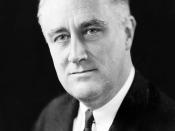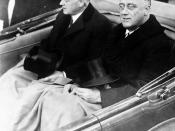When the veterans came back from World War I, they found many changes, not the least of which was an absence of alcoholic beverages. The nation, much of which was dry already had decided to get rid of the bars (saloons) , once and for all. As early as 1916, a total of 23 out of 48 states had already passed antisaloon laws.
The movement was undertaken to reduce crime and corruption, improve health, solve social problems and reduce the tax burden created by prisons and poorhouses.
Prohibition was called "The Noble Experiment" by Herbert Hoover. The 18th Amendment to the Constitution prohibited the manufacture, sale or transportation of intoxicating liquors. When the amendment came before the Senate in 1917, it was passed by a one-sided vote after only 13 hours of debate.
When the House of Representatives accepted it a few months later, the debate took only a day.
The state legislatures ratified it in short order and by January of 1919, two months after those decisions, the necessary three-quarters of the states had voted toward the amendment and the amendment was part of the Constitution.
A number of Americans probably approved of the prohibition but the public rapidly grew tired of it. Communities filled with "bootleg" whiskey and displayed it openly. Soon every community of any size had their "speakeasies" where both imported and homemade alcohol could be purchased.
These underground saloons made a lot of business. Keeping them supplied was the occupation for many thousands of bootleggers, who were forced to work beyond the law. All too often, differences of opinion resulted in open warfare and murders. Thanks to technology, they had new and deadly weapons at their hands.
Inevitably most of the liquor traffic fell into the hands of gangsters, whose names we still...


